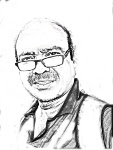Body Movements
1. Fill in the blanks
1. The framework of bones in our body is called the skeleton.
2. The backbone is made up of many small bones called vertebrae.
3. The backbone protects the spinal cord.

4. Bones are vertebrate in birds.
5. Joints of the bones help in movement the of the body.
6. A hard rounded structure i snail is called the invertebrate.
7. A snake moves smoothly over a surface by making twisting motion.
B. Multiple choice questions
1. Knee joint is an example of
ans. Hinge joint
2. Which of the following is not a movable joint?
ans. joints in the skull
3. The joint which allows movement in all directions is
ans. ball and socket joint
4. The bones at the joints are help together by
ans. ligaments
5. Which of these acts as a shock absorber at the joints?
ans. cartilage
6. The number of ribs in the human body is
ans. 12 pairs
C. Very short answer (one word)
1. Number of vertebrae in the spine
ans. 33
2. Point at which two or more bones meet
ans. Joints
3. Largest bone in the human body
ans. femur
4.Total number of bones in human body
ans.206
5.Hallow bones are found in which animals?
ans.Ostriches and emu birds
6.The only movable bone in the skull
ans. Jaw
D. Short answer questions.
1. Why do animals move from one place to another?
ans. Animals move from one place to another in search of food, shelter and suitable environment that protect them.
2. List any three functions of skeleton.
ans. Three functions of the skeleton are
(i) It gives shape to the body.
(ii) It it protects softer parts of our bodies
(iii) It provides numerous points in our body for the attachment of muscles.
3. What are joints name the four kind of joints.
Ans. Joints are the places where two or more bones meet.Four kinds of joints are
(i) Ball and socket joint
(ii)Pivotal joint
(iii) hinge joint
(iv) Gliding joint
4. What is cartilage? How is it useful?
ans. Cartilage is the soft tissue present present at the end of the bones. Cartilage acts as a shock absorber and reduces friction between the bones.
5. What are the functions of spine or backbone?
ans. There are following functions of Backbone.
(i) Backbone provide main support to the body
(ii) Backbone supports the head at the top.
(iii) It attaches shoulder,rib and hip bones.
(iv) Backbones protect the spinal cord.
6. List two adaptation in birds that help them to fly.
ans. Streamlined body or boat-shaped body and hollow bones
D. Long answer questions
a Ligament and tendon.
Ligament:- It is the strong, stretchy structures that hold the bones together at the joints
Tendon:- It is the strong band that join muscles to bones.
b. Ball Socket Joints and Hinge joint
Ball Socket:-It allows movement in all directions e.g. shoulder joint, hip joint etc. It is freely movable joint.
Hinge Joint:- Movement takes place about a single axis in one plane only and resembles the to and fro swing like the hinges of a door, eg. knee joint, elbow joint etc.
2. How do the following move?
ans. a. earthworm b. snake c. fish
Earthworm:- When the earthworm moves, the circular muscles contract first, and the body becomes thinner and longer and the front part is fixed to the surface with the setae. When te longitudinal muscles contract, the body becomes shorter and teh hind part is pulled up.
Snake: Snake's body curves into many loops . Each loop gives it a forward push by pressing against the ground. Thus, the snake moves forward very fast and not in the straight line.
Fish:- The skeleton of the fish is covered with strong muscles. During swimming, muscles make the front part of the body curve to one side and the tail part swings towards the opposite side. This makes a jerk and pushes the fish forward. A series of such jerks help the fish swim ahead.
Next Chapter:
The Living Organisms and Their Surroundings Class VI.
Labels: Class VI, Notes for students


0 Comments:
Post a Comment
Subscribe to Post Comments [Atom]
<< Home